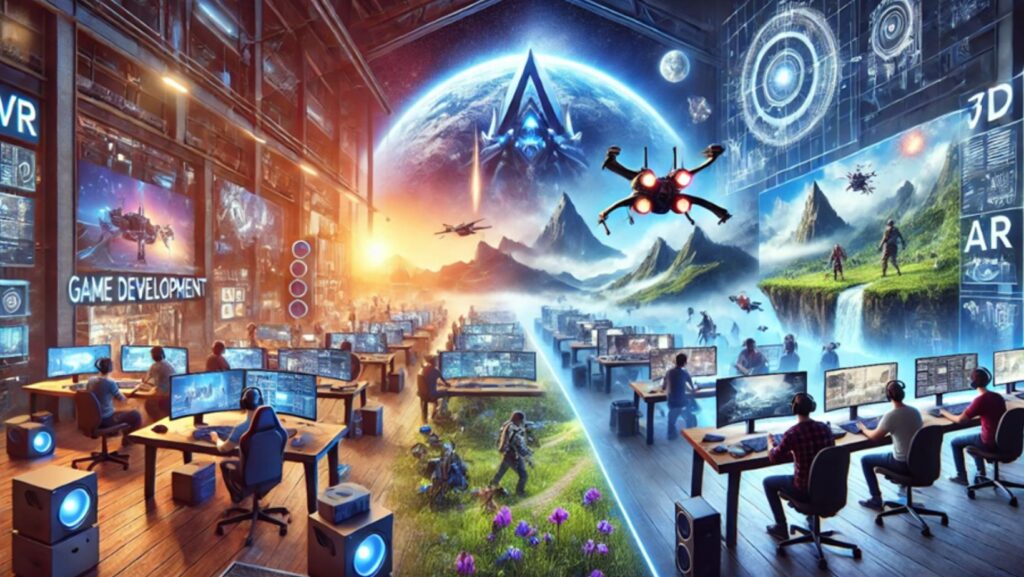

The gaming world is always breaking new ground with its amazing 3D game development, crafting virtual worlds that really draw you in. Today’s games take players on a journey through stunningly detailed settings, where every little detail adds to a more exciting experience. This deep dive looks at how game developers leverage different elements of 3D design to build experiences that are truly immersive.
Creating Visual Excellence
The visual quality of modern games plays an important role in attracting and immersing players into the virtual worlds. Gaming company invest substantial resources in developing realistic graphics that make games more real, believable and engaging. Studios focused on visual excellence often collaborate with a 3D game art studio to craft highly detailed characters, textures, and environments that elevate immersion. Modern 3D modeling techniques allow developers to create incredibly detailed characters and environments that closely mirror reality.
Advanced texturing techniques bring these 3D models to life. Developers use specialized mapping methods to apply realistic surface details, making everything from character skin to building materials look authentic. The careful application of these textures ensures that every surface in the game world appears natural and convincing.
Lighting is crucial for establishing atmosphere and depth in gaming. Contemporary games utilize dynamic lighting systems that produce lifelike shadows and set the mood effectively. These lighting methods are instrumental in conveying the time of day, weather variations, and the emotional ambiance of various game environments, enhancing the sense of realism and interactivity in the virtual world.
Building Realistic Environments
Game environments now tell their own stories through careful design and attention to detail. Developers create worlds filled with environmental clues that hint at past events or upcoming challenges. This approach to world-building helps players feel like they’re exploring living, breathing spaces rather than artificial gaming environments.
Modern games often use procedural generation techniques to create vast, varied landscapes efficiently. This technology allows developers to generate unique environments automatically while maintaining consistent quality and design principles. The result is expansive game worlds that feel natural and encourage exploration.
The Power of Sound Design
Sound design in contemporary gaming has reached new levels of sophistication. The environmental audio knits complex layers of atmosphere that react to player actions and in-game events. From the soft rustle of leaves in the wind to the echo of footsteps in deserted hallways, these auditory hints enrich and beautify the overall gaming experience.

Exceptional voice acting breathes life into game characters, making interactions feel authentic and significant. Skilled voice performances contribute to the development of character identities and amplify emotional scenes, pulling players further into the game’s storyline.
Crafting Engaging Stories
Modern games often feature complex narratives that is as interesting and captivating as those found in movies and books. Gaming companies now employ professional writers to create detailed storylines that keep players invested in the game world. These stories often include:
- Multiple narrative paths based on player choices
- Complex character relationships that develop over time
- Background lore that adds depth to the game world
- Emotional story arcs that resonate with players
Interactive Gameplay Elements
The way players interact with game worlds has evolved significantly. Modern games offer more meaningful choices that affect all parts of gaming such as how the outcome of the story is and what is the gameplay experience of the player. This level of interactivity helps players feel more connected to their gaming experience and more invested in their decisions.
Emerging Technologies
Virtual Reality (VR) has changed how one interacts with games. It is unlike all traditional game as it provides with tye highest level of immersion by transporting its players to the virtual world. The ability to look around freely and engage with objects through natural movements, the gaming experience becomes more lifelike and believable than ever.
On the other hand, Augmented Reality (AR) takes another distinctive route to immersion by incorporating digital components into the physical environment. This technology crafts unique gaming experiences that reverberate with players’ real-life surroundings while threading interactive digital features.
Creating Emotional Connections
Modern games excel at building emotional connections with players through various techniques:
- Detailed character expressions and animations that convey genuine emotions
- Meaningful dialogue choices that affect relationships with game characters

- Consequence-based decision making that carries real emotional weight
- Cinematic storytelling techniques that highlight dramatic moments
Outstanding Examples in Modern Gaming
There are several great examples of the gaming industry using 3D to enhance immersive in games for player experience. Some of the great examples are:
- Red Dead Redemption 2: The game is a magnum opus of environmental design and attention to detail. It successfully creates an incredible and believable world through lifelike character animations and a lively ecosystem with wildlife behaving naturally and weather patterns changing the gameplay. The level of details and minute to even the smallest of interactions such as mud accumulating on clothes or snow leaving tracks,, thus creating a deeply immersive experience.
- The Witcher 3: Wild Hunt: This game demonstrates how storytelling and world-building can create emotional investment. The vast landscape of the game is filled with meaningful content and detailed environments that tell their own stories. The game’s characters display depth of character and complexity through well-crafted dialogue and complex personal histories, making player interactions feel significant and emotionally deep.
- Grand Theft Auto V: The game demonstrates how a living, breathing world can enhance immersion. The game’s city feels authentic thanks to sophisticated AI systems that govern NPC behavior. Citizens react realistically to player actions, traffic follows believable patterns, and the urban environment buzzes with activity that makes the virtual city feel alive.
The Future of Gaming Immersion
As technology keeps growing and crossing new boundaries, gaming companies are uncovering innovative methods to enrich the experience of players through immersion in virtual worlds. The blend of such intricate graphics, convoluted sound design, captivating narratives, and emerging technologies results in increasingly realistic gaming experiences for all ages. This continuous development indicates that upcoming games will provide even greater levels of immersion.
The gaming sector’s commitment to enhancing immersion through 3D development is transforming how players engage with virtual environments. By merging technical skill with artistic vision, gaming companies craft experiences that not only entertain but also genuinely transport players to new realms. With ongoing technological advancements, these immersive experiences are expected to become even more compelling and engaging.












